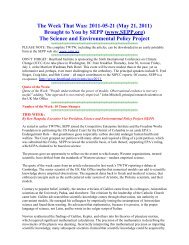Mar 19, 2011 - Science & Environmental Policy Project
Mar 19, 2011 - Science & Environmental Policy Project
Mar 19, 2011 - Science & Environmental Policy Project
Create successful ePaper yourself
Turn your PDF publications into a flip-book with our unique Google optimized e-Paper software.
among the fuel rods to control the rate of the nuclear reaction and the amount heat given produced. The<br />
nuclear reaction is shut down by full insertion of these rods. However, the continuing radioactive decay of<br />
the products of the nuclear reaction in fuel rods still give off heat even after the reactor is shut down. For<br />
that reason the fuel assemblies must be immersed in water or some other coolant. If the coolant is lost, the<br />
fuel rods may reach temperatures so high they melt.<br />
Adding to the difficulty, if the fuel rods are exposed to air / steam, the zirconium that coats the rods<br />
combines so strongly with oxygen, that it can strip oxygen from steam, forming free hydrogen. Hydrogen<br />
is so chemically reactive that it is not found in the atmosphere. It burns rapidly in the atmosphere, giving<br />
the impression of an explosion.<br />
Three reactors were closed for maintenance and refueling, but contained fuel rods or fuel rods that were<br />
kept in storage pools. Retrospectively, a design flaw emerges: these cooling pools were built above the<br />
containment structures.<br />
The US Geological Survey reports that the earthquake that struck Japan last Friday is the strongest ever<br />
recorded with modern instrumentation to hit Japan and the fourth strongest since <strong>19</strong>00. The Richter scale<br />
used to measure earthquakes is a base ten logarithmic scale. Thus a 9 point earthquake is 10 times<br />
stronger than an 8 point earthquake. The strongest earthquake recorded, 9.5, hit Chile in <strong>19</strong>60 (which also<br />
caused tsunami waves to hit Japan).<br />
Northeastern Japan is in a geologic subduction zone where the oceanic plate is being forced into the<br />
earth’s mantle which often results in severe earthquakes. Though not the only cause, these types of plate<br />
movements are the most common cause of tsunamis. By contrast, slip faults, where one plate is sliding<br />
against another, are not typically associated with significant tsunamis. One example is what is occurring<br />
in southern California where Los Angeles which is moving north relative to the continent.<br />
Apparently, the earthquake destroyed the electric grid to which the nuclear plant is connected, but did not<br />
damage the plant. With the loss of the grid, the control rods were fully inserted into the fuel assemblies<br />
stopping the nuclear reactions in the active reactors. The backup diesel engines to generate emergency<br />
electrical power turned on providing the necessary circulation of water needed to keep the fuel rods from<br />
overheating.<br />
About an hour later, the tsunami overwhelmed the sea wall damaging or destroying the diesel backup for<br />
the electricity to the pumps providing cooling water. A second backup of batteries may or may not have<br />
worked, but if they did the batteries were quickly drained. The cooling water overheated into steam and<br />
some of the fuel rods likely melted. The reaction between the hot fuel rods and the steam probably created<br />
hydrogen within the containment chambers.<br />
When plant workers opened valves to release pressure from the chambers, the hydrogen escaped which<br />
burned so rapidly in the atmosphere that it virtually exploded. This resulted in damage to the outer shells,<br />
so displayed in photographs, but immaterial to the structural strength of the two containment structures.<br />
How the burning of the hydrogen gas affected the cooling pools on top of the containment structures is<br />
not clear. With the release of pressure, some radioactive gas escaped into the atmosphere.<br />
The earthquake and tsunami effectively destroyed regular communications between plant operators and<br />
the corporate and government leaders. This probably delayed the decision to flood the overheating<br />
reactors with sea water which would effectively destroy them for further use.<br />
What appears to be the most prolonged problem were the pools used for cooling the fuel assemblies.<br />
While the conditions in the reactors were being brought under control it appears that water in some of the<br />
2





